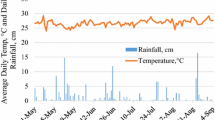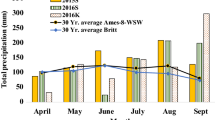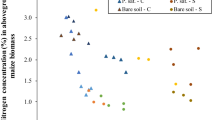Abstract
In cover cropping systems in the tropics with herbaceous legumes, plant residues are expected to supply nitrogen (N) to non-legume crops during decomposition. Field experiments were carried out to (i) determine the effects of residue quality on decomposition and N release patterns of selected plants in cover cropping systems, (ii) relate the pattern of residue N release to N uptake by maize in cover cropping systems. To study decomposition, litter bags were used and monitored over two maize growing seasons. The residues studied were mucuna (Mucuna pruriens (L.) DC. var. utilis (Wright) Bruck), lablab (Lablab purpureus (L.) Sweet), and leaves and rhizomes of imperata (Imperata cylindrica (L.) Raueschel). Mucuna and lablab decomposed rapidly losing more than 60% of their dry weight within 28 days. In contrast, imperata decomposed slowly with only 25% of its dry matter lost in 56 days. At 28 days, mucuna had released 154 kg N ha-1 in in-situ mulch systems and 87 kg N ha-1 in live- mulch systems representing more than 50% of its N. More than 64% of N in lablab was released within 28 days amounting to 21 to 174 kg N ha-1. Imperata rhizomes mineralized 4 to 14 kg N ha-1 within 14 days, and subsequently immobilized N until 112 days whereas imperata leaves immobilized N throughout the study period. Decomposition and N release rates from the plant residues were most strongly correlated with the (lignin+polyphenol)/N ratio, N content, lignin/N ratio, polyphenol/N ratio, C/N ratio and lignin content of the residues. Relative to the controls, herbaceous legume residues increased maize dry matter yield and N uptake during the two cropping seasons. At 84 days, the maize crop had utilized 13 to 63 kg N ha-1from mucuna representing 13 to 36% of N released, whereas 16 to 25% of N released from mucuna was recovered by the maize crop at 168 days. The first maize crop recovered 9 to 62 kg N ha-1 or 28 to 35% of N released from lablab. However, at 168 days, N uptake by maize in antecedent live-mulched lablab was 32% higher than the quantity of N released, whereas imperata residues generally, resulted in net reduction of maize N uptake.
Similar content being viewed by others
References
Amato M (1983) Determination of 12C and 13C in plant and soil. Soil Biol Biochem 5: 611–612
Anderson JM and Ingram JS (1993) Tropical Soil Biology and Fertility: A handbook of methods. CAB International, Wallingford, UK, pp 221
Bremmer JM & Mulvaney CS (1982) Nitrogen – Total. In: Page AL, Muller RH & Keeney DR (eds) Methods of Soil Analysis, Part 2, pp 595–624. American Society of Agronomy, Madison, Wisc
Eaglesham ARJ, Ayanaba AA, Ranga Rao V & Eskew DL (1982) Mineral N effects on cowpea and soybean crops in Nigerian soil. I. Amounts of N2 fixed and accrual to the soil. Plant Soil 68: 183–192
Fog K (1988) The effect of added nitrogen on the rate of decomposition of organic matter. Biol Rev 63: 433–462
Fox RH, Myers RJK & Vallis I (1990) The nitrogen mineralisation rate of legume residues in soil as influenced by their polyphenol, lignin and nitrogen contents. Plant Soil 129: 251–259
Frankenberger WT & Abdelmagid HM (1985) Kinetic parameters in nitrogen mineralization rate of leguminous crops incorporated into soil. Plant Soil 87: 257–271
Harris GH & Hesterman OB (1990) Quantifying the nitrogen contribution from alfalfa to soil and two subsequent crops using nitrogen-15. Agron J 82: 129–135
Haynes RJ (1986) The decomposition process: mineralisation, immobilisation, humus formation and degradation. In: Haynes RJ (ed.) Mineral Nitrogen in Plant-soil System, pp 52–126. Academic Press, London
Ibewiro B (1998) Nitrogen availability and soil organic matter transformations under herbaceous legume cover cropping systems in imperata cylindrica infested tropical savanna. Ph.D. thesis, Katholieke Universiteit, Leuven, Belgium, pp 181
Ibewiro B, Vanlauwe B Sanginga N & Merckx R (1998) Nitrogen contributions of roots to succeeding maize in herbaceous legume cover cropping systems in a tropical derived savanna. In: Renard G, Neef A, Becker K & von Oppen M (eds) Soil Fertility Management in West African Land use Systems, pp.123–128. Margraf Verlag, Weikersheim, Germany
IITA (International Institute of Tropical Agriculture) (1982) Automated and semiautomated methods for plant and soil analysis. Manual Series No. 7, IITA, Ibadan, Nigeria, pp 56
Jenkinson D S (1981) The fate of plant and animal residues in soil. In: Greenland DJ & Hayes MBH (eds) The Chemistry of Soil Processes, pp 505–561. John Wiley and Sons, Chichester, UK
Kang BT, Sippens L, Wilson GF & Nangiu UD (1981) Leucaena pruning as nitrogen source for maize. Fert Res 2: 279–287
McDonagh JF, Toosman B, Limpinuntana M & Giller KE (1995) Grain legumes and green manures as pre-rice crops in Northeast Thailand II. Residue decomposition. Plant Soil 177: 127–136
Muller MM, Sundaman V, Soininvaara R & Merilainen A (1988) Effects of chemical composition on the release of nitrogen from agricultural plant materials decomposing in soil under field conditions. Biol Fertil Soils 6: 78–83
Mulongoy K & van der Meersch MK (1988) Nitrogen contributions by Leucaena pruning to maize in an alley cropping system. Biol Fertil Soils 6: 282–285
Mulongoy K & Akobundu IO (1990) Agronomic and economic benefits of nitrogen contributed by legumes in live-mulch and alley cropping systems. In: Gresshoff PM, Roths LR, Stacey G & Newton WE (eds) Nitrogen Fixation: Achievements and Objectives, pp 625–632. Chapman and Hall, New York
Myers RJK, Palm CA, Cuevas E, Gunatillekel UN & Brossard M (1994) The synchronisation of nutrient mineralization and plant nutrient demand. In: Woomer PL & Swift MJ (eds) The Biological Management of Tropical Soil Fertility, pp 81–116. John Wiley and Sons, Chichester, UK
Oglesby KA & Fownes JH (1992) Effects of chemical composition on nitrogen mineralization from green manures of seven tropical leguminous trees. Plant Soil 143: 127–132
Palm CA & Sanchez PA (1991) Nitrogen release from the leaves of tropical legumes as affected by their lignin and polyphenol contents. Soil Biol Biochem 23: 83–88
Sanginga N, Mulongoy K & Ayanaba A 1988 Nitrogen contributions of leucaena/ rhizobium symbiosis to soil and subsequent maize crop. Plant Soil 112: 137–141
SAS (1990) SAS Procedures Guide, version 6, 3rd edition. Statistical Analytical System (SAS) Institute, Caryn., NC, USA, pp 705
Swift MJ, Heal OW & Anderson JM (1979) Decomposition in terrestrial ecosystems. Blackwell Scientific, Oxford, pp 372
van Soest PJ (1963) Use of detergents in the analysis of fibrous feed. II. A rapid method for the determination of fibre and lignin. J Ass Of Analyt Chem 46: 929–935
Vanlauwe B, Swift MJ & Merckx R (1996) Soil litter dynamics and N use in Leucaena alley cropping systems in Southwestern Nigeria. Soil Biol Biochem 28: 739–749
Vanlauwe B, Sanginga N & Merckx R (1997) Decomposition of four Leucaena and Senna prunings in alley cropping systems under subhumid tropical conditions: the process and its modifiers. Soil Biol Biochem 29: 131–137
Xu H, Myers RJK, Saffinga PG & Chapman AL (1993) Nitrogen cycling in Leucaena alley cropping in semi-arid tropics. Mineralisation of nitrogen from leucaena residues. Plant Soil 148: 63–72
Author information
Authors and Affiliations
Corresponding author
Rights and permissions
About this article
Cite this article
Ibewiro, B., Sanginga, N., Vanlauwe, B. et al. Nitrogen contributions from decomposing cover crop residues to maize in a tropical derived savanna. Nutrient Cycling in Agroecosystems 57, 131–140 (2000). https://doi.org/10.1023/A:1009846203062
Issue Date:
DOI: https://doi.org/10.1023/A:1009846203062




